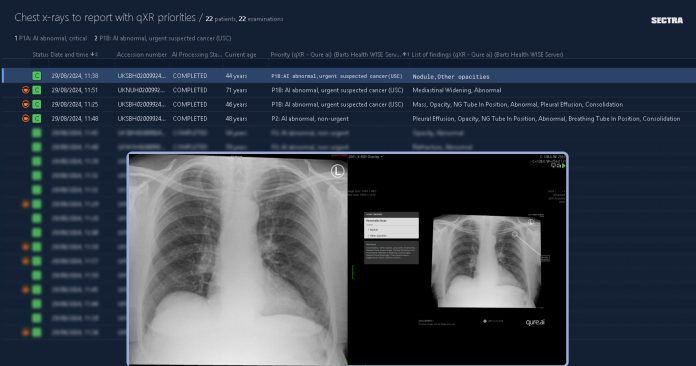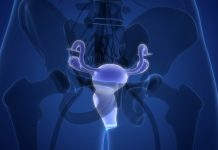Surabhi Srivastava, Commercial Head UK and EU at Qure.ai, discusses how integrating artificial intelligence can reduce chest X-ray reporting times and accelerate early lung cancer diagnosis
Healthcare systems across the UK face unprecedented demand and workforce shortages, particularly in radiology. In 2024–2025 alone, 7,272 people in North East London were diagnosed with cancer, and over 52,900 were living with the disease. During this period, 88,040 patients underwent Faster Diagnosis Standard referrals for suspected cancer, with 96.4% receiving the all-clear, highlighting the immense scale and urgency of diagnostic services.
The North East London Cancer Alliance, in collaboration with Qure.ai and Sectra, is integrating qXR, an artificial intelligence (AI) solution, into lung cancer diagnostic pathways, significantly reducing reporting turnaround times and improving patient outcomes.
Established in April 2020 under NHS England’s Cancer Alliance programme, North East London Cancer Alliance collaborates closely with providers, commissioners, and community partners across eight boroughs. It now serves approximately 3 million residents through key partners: Barts Health NHS Trust, Barking, Havering and Redbridge University Hospitals NHS Trust, and Homerton Healthcare NHS Foundation Trust.
Early benefits and impact
qXR uses “prioritisation buckets” to automatically categorise chest X-rays by severity, ensuring radiologists rapidly address urgent cases without overlooking critical findings.
- 61.5% improvement: Turnaround for critical cases reduced from 13 to five days.
- 41.7% improvement: Urgent cancer case reporting times dropped from 12 to seven days.
- Three-day goal: The target is a consistent three-day turnaround for all chest X-ray reports.
- 244 critical findings flagged:
AI identified significant pathology in 244 out of 5,136 chest X-rays. - 10 missed cases detected: AI caught ten critical cases initially overlooked by clinical staff.
Clinical leads across participating Trusts report overwhelmingly positive feedback. Junior doctor training is underway to leverage AI effectively and minimise unnecessary CT scans.
Addressing critical challenges
Local radiology departments have faced escalating pressure over the past five years.
- 94% surge in demand: Chest X-ray requests rose from 139,080 in 2017 to approximately 270,000 in 2022.
- 29% workforce short fall: National radiologist gap severely limits diagnostic capacity.
- Three-week backlogs:Patients at Trusts like Barts Health NHS Trust waited an average of 21 days for X-ray results.
- Misreads in emergency departments: Critical findings are often misidentified, leading to unnecessary CT scans, higher patient radiation exposure, and strained resources.
AI deployment for enhanced care
To address these challenges, North East London Cancer Alliance partnered with Qure.ai to embed qXR chest X-ray AI into its lung cancer diagnostic pathway.
Wayne Douglas, Programme Lead at North East London Cancer Alliance, notes:
“Integrating Qure’s Chest X-ray AI into the radiology workflow has improved the ability to quickly identify and prioritise critical cases. By flagging urgent findings, clinical teams are able to intervene promptly, supporting timely diagnosis, treatment, and efficient resource use across North East London. This marks a step towards understanding how healthcare technology can assist in identifying cancers at earlier stages and support broader clinical pathways.”
This structured approach ensures rapid identification of critical cases, helping healthcare providers promptly allocate resources to urgent findings while effectively managing normal scans.
Patient-centric care and workforce support
Patient feedback highlights the value of this AI initiative. Previously, patients endured prolonged waits and uncertainty, which was particularly distressing for those facing potential cancer diagnoses. Now, they receive rapid, accurate diagnostics, offering earlier intervention or reassurance. This aligns with NHS England’s National Optimal Lung Cancer Pathway’s aim for same-day diagnostics (“zero-day appointments”), with plans underway to incorporate AI-driven CT scans.
By streamlining workflows and enabling rapid triage of life-threatening conditions, this deployment eases strain on radiology departments, especially beneficial in high-risk, diverse regions such as Newham and Tower Hamlets.
Power of partnerships in AI activation
The successful deployment of AI in North East London’s lung cancer pathway illustrates the strength of strategic collaboration. North East London Cancer Alliance, alongside digital technology leaders Qure.ai and Sectra, demonstrates how public- private partnerships can swiftly scale innovative solutions and transform patient outcomes. For Qure.ai, this aligns with a broader vision: integrating AI into routine imaging workflows to accelerate early lung cancer detection, delivering timely, potentially life-saving interventions. Effective AI integration required coordinated clinical alignment, data governance, system integration, and user training.
Surabhi Srivastava, Head of UK Business at Qure.ai, says:
“We’re delighted to collaborate with North East London Cancer Alliance to optimise its radiology workflow and diagnostic lung cancer pathway. Quickly identifying suspicious lung nodules or masses on chest X-rays helps move patients swiftly through their diagnostic journey, potentially improving survival through earlier diagnosis.”
“This deployment is a true partnership, balancing clinical needs, information governance, and seamless AI integration into healthcare systems. Post-deployment, we focus on user training and patient awareness,” Srivastava adds.
Next steps and continuous improvement
North East London Cancer Alliance remains dedicated to continuous improvement through structured training, employing initial “kick-off” sessions followed by a sustainable, train-the-trainer model. A comprehensive two-year evaluation is underway, with initial data already shared with NHS England demonstrating improved reporting turnaround and patient pathways. Efforts continue to capture downstream metrics, including time-to- CT and time-to-diagnosis, to better understand long-term AI impacts.

This work is licensed under Creative Commons Attribution-NonCommercial-NoDerivatives 4.0 International.











